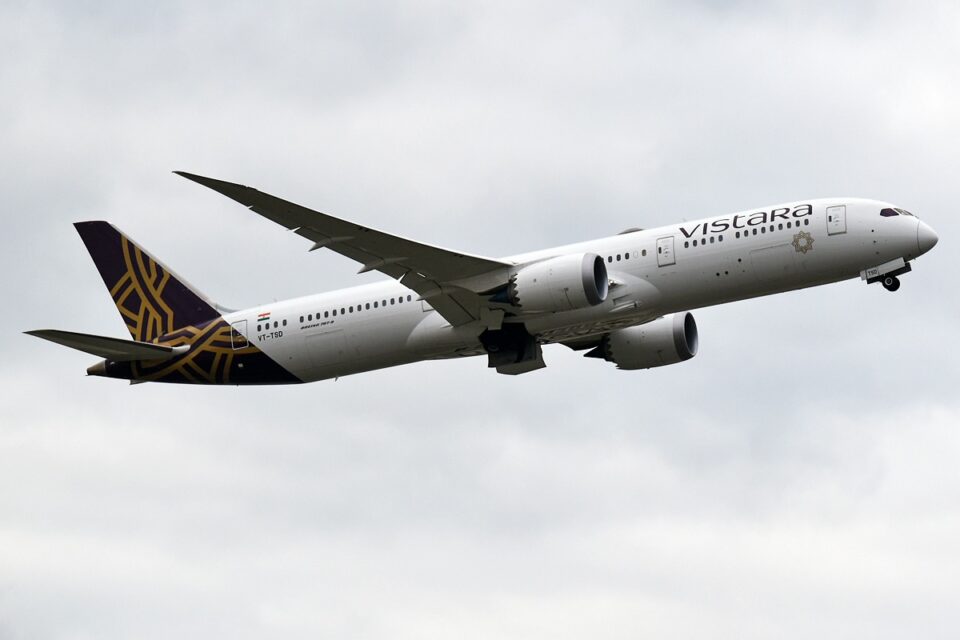Airlines
Vistara announces direct flights between Mumbai and London

A new long-haul route has been added to the expanding international network of Vistara, India’s best full-service airline and a joint venture of Singapore Airlines and the Tata Group. With direct, five times weekly flights between Mumbai and London beginning on June 1, 2023, the airline will increase its presence at LHR (London Heathrow).
Air India resumes its non-stop service between Mumbai and New York(Opens in a new browser tab)
As it improves connectivity between India and the UK, Vistara will fly its brand-new Boeing 787-9 Dreamliner on the route. This aircraft has a three-class layout. Reservations for the flights are gradually becoming available across all platforms, including through travel agencies, the Vistara website, and mobile apps.
INTRODUCTORY ALL-INCLUSIVE, ROUND-TRIP FARES BETWEEN MUMBAI AND LONDON
| Sector | Economy | Premium Economy | Business |
| Mumbai – London – Mumbai | INR 57,799 | INR 102,199 | INR 241,399 |
| London – Mumbai – London | GBP 459 | GBP 899 | GBP 2,539 |
SCHEDULE OF FLIGHTS BETWEEN MUMBAI AND LONDON (UNITED KINGDOM)
EFFECTIVE 01 JUNE 2023
| Sector | Flight No. | Days of Operation | Departure | Arrival |
| Mumbai – London | UK 015 | Mondays | 1350 hrs | 1910 hrs |
| Tuesdays
Thursdays Fridays Sundays |
1430 hrs | 1955 hrs | ||
| London – Mumbai | UK 016 | Mondays | 2055 hrs | 1015 hrs (+1) |
| Tuesdays
Thursdays Fridays Sundays |
2155 hrs | 1100 hrs (+1) |
Vistara will accept all eligible customers meeting visa/entry requirements in both countries, as specified by the respective government bodies. Vistara strongly encourages its customers to fully understand these guidelines before making their bookings.

Airlines
Virgin Australia Launches Black Friday Sale on Flights Worldwide

Virgin Australia has launched its much-anticipated 2024 Black Friday sale, offering unbeatable deals on both domestic and international flights.
With fares starting at just $49 for one-way domestic flights and return fares to New Zealand as low as $405, this is a fantastic opportunity for travelers to save big. The sale is available for bookings made between November 28 and December 5, with travel dates ranging from January 6 to September 18, 2024.
Whether you’re looking to explore Australia or venture abroad, these discounts cover Virgin Australia’s entire network.
Tejas and C-390 Millennium: India and Brazil’s Defense Trade Vision
For domestic travel, Virgin Australia is offering one-way flights starting at $49, with the cheapest route being Sydney to Ballina Byron. Other attractive domestic deals include flights from Sydney to Gold Coast from $65, Melbourne to Hobart from $85, and Brisbane to Prosperine from $79.
Additionally, flights to iconic Australian destinations like Hamilton Island, Uluru, and the Whitsundays are available at significantly reduced prices, providing excellent options for those looking to explore more of the country.
International travelers can also take advantage of great offers, with return flights to popular destinations like New Zealand, Bali, and Fiji. Notable international deals include return flights from Sydney to Queenstown (New Zealand) for $435, Melbourne to Denpasar (Bali) for $589, and Brisbane to Port Vila (Vanuatu) for $499. These discounts offer an excellent chance to visit exotic locales without breaking the bank.
This international airline is offering free flight tickets to Indian travelers
Virgin Australia’s sale covers a wide range of routes from major cities across Australia. For example, from Sydney, you can fly to Melbourne for just $89, Adelaide for $119, and Perth for $209 one-way. Melbourne residents can take advantage of flights to Brisbane from $119, Darwin from $205, and Nadi (Fiji) from $599 return.
Brisbane-based travelers can book one-way flights to Hamilton Island from $109 or to Apia (Samoa) from $689 return, while Perth residents can enjoy flights to Broome for $179 and Darwin for $219 one-way.
The sale also includes affordable fares from Adelaide, Hobart, and Darwin. Adelaide to Gold Coast is available from $109, while Hobart to Melbourne is priced at $85 one-way. In Darwin, flights to Adelaide start from $139, and one-way flights to Melbourne are available from $205.
Virgin Australia’s Black Friday sale began at midnight on November 28 and runs until 11:59 PM on December 5. Travelers can book flights for travel between January 6 and September 18, 2024, ensuring plenty of options for future trips. Whether you’re planning a domestic getaway or an international adventure, these limited-time offers make now the perfect time to book your next flight.
-

 Aviation2 months ago
Aviation2 months agoMicrosoft Flight Simulator Raises $3 Million to Bring Back the An-225 Mriya
-

 Airlines2 months ago
Airlines2 months agoQatar Citizens Can Travel to the United States Without a Visa
-

 Aviation2 months ago
Aviation2 months agoQatar Airways bans these new Electronic Devices on plane
-

 Defence2 months ago
Defence2 months agoWhich Country Has the Largest Fleet of Fighter Aircraft?
-

 Airlines6 days ago
Airlines6 days agoDAMAC Air: Dubai’s New Luxury Airline Offers Free Flights for Registration
-

 Airport2 months ago
Airport2 months agoWestern Sydney Airport Welcomes Its First Plane After 6 Years of construction
-

 Airlines5 days ago
Airlines5 days agoAir India to Launch aircraft maintenance training institute in Bengaluru
-

 Aviation2 months ago
Aviation2 months agoDid you know ? Once Boeing 747 carried 1088 passenger in 1991








